Intel X58 Motherboard Roundup - What does $300 Get You?
by Gary Key on December 5, 2008 3:00 PM EST- Posted in
- Motherboards
ASUS P6T Deluxe
Features
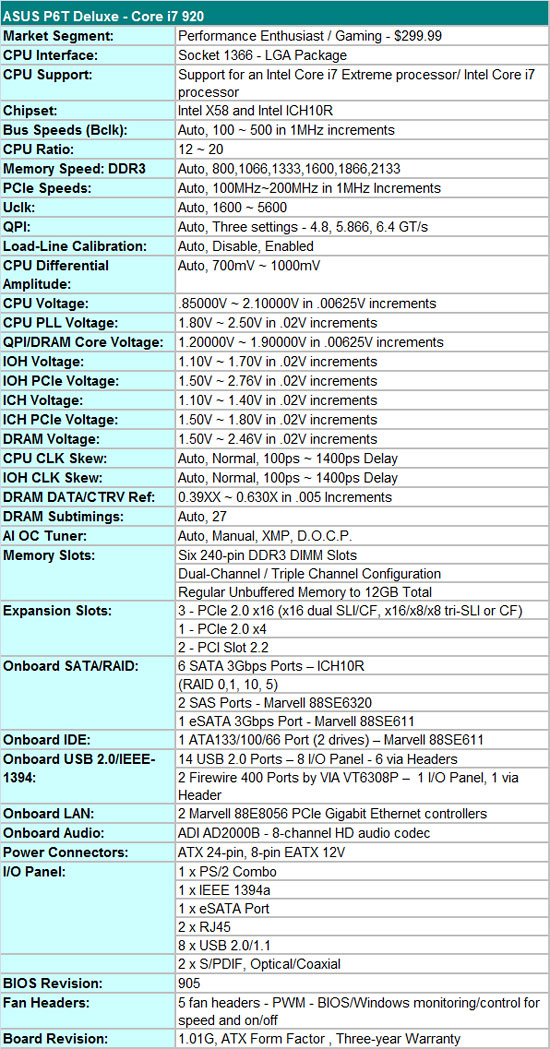
ASUS offers the P6T Deluxe in two different versions, one with the OC Palm external display module for $338 and one without for $299. The OC Palm was originally introduced as the ScreenDuo last year and features a 2.5" QVGA display, four-way directional pad, and four input buttons. It attaches to the motherboard via a USB cable and features a clean, uncluttered, and simplistic interface that allows the user to interface with various ASUS software programs. The user can monitor various hardware functions or do on-the-fly overclocking. The unit allows real-time changes to the processor's Bclk along with voltages for QPI, memory bus, and the CPU. We would like to see additional overclocking variables along with the ability to save profiles to the BIOS or real-time changes to the BIOS. Overall, it is a unique feature and fun to play with for about 30 minutes, but for most users we would suggest saving the money and buying the base board - A board that we might add is one of our favorites in the lab since it first arrived.
Not to take anything away from our other boards as they are all very good with one bordering on being great, but the ASUS P6T-Deluxe impressed us with its ability to just work as expected out of the box. While we provided several suggestions to ASUS for improvements, they mainly centered on tuning aspects, not getting basic functions to work properly before we could even consider testing. That may seem trivial, but unfortunately it is not if you are an early adopter of high-end motherboards.
The BIOS is designed for a wide variety of users who want to get the most out of a board when overclocking. Some of the voltage ranges are not as wide as Gigabyte's, nor do you have the ability to control each individual memory channel, but the options available will more than suffice for most users. We also think the ASUS BIOS is more user friendly due to the information provided for each option. However, ASUS continues to use the terminology QPI/DRAM instead of VTT as the other boards do.
ASUS features memory speeds from 800MHz to 2133MHz memory for the i920/i940 processors along with opening up QPI link speeds from a standard 4.800 GT/s up to 6.400 GT/s. We are disappointed with the number of OC profiles in the BIOS. ASUS has three OC profiles compared to up to eight on the other boards.
The board officially supports 12GB of DDR3 memory, although we expect full support for 24GB in a future BIOS release. Running 12GB of memory on this board is extremely easy and it usually requires less voltage while providing tighter timings than the other boards. Our 12GB Patriot and G.Skill DDR3-1600 kits were 24/7 stable at 1600 with 8-8-8-24 1T timings, although we needed about 1.66V for absolute stability. The Gigabyte board offered slightly better latency results with 9-8-8-24 1T timings, but the ASUS board was just slightly faster in most of the benchmarks except for WinRAR. Of course, your mileage will vary with different memory kits and sub-timings, and outside of memory benchmarks the net difference is generally less than 1%.
One last item of note, at least in this first look, is that the three PCI Express 2.0 x16 slots will operate in x16/x16 mode for 2x SLI/CF if the third x16 slot is empty. If you decide to place a PCIe RAID, network, audio, or TV tuner card in the third x16 slot, then the 2x SLI/CF configuration will operate in x16/x8 mode. We did not notice any performance differences between the two modes with our HD 4870 or GTX 260 cards. 3x SLI/CF configurations will run in x16/x8/x8 mode. You can also use the first and third x16 slots for graphics if you need to open up a PCI slot but the board will run in x16/x8 mode. Although the owner’s manual states the three x16 slots are for graphics cards only, we had no problems running our ASUS Xonar D2X or Highpoint Rocket RAID cards in x16 slot two or three.
The Board
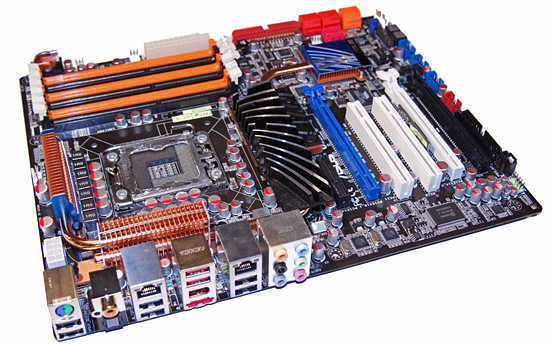
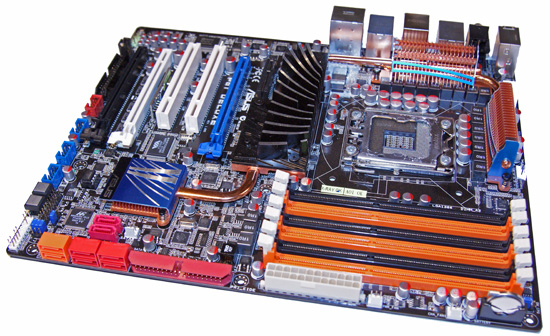
The P6T Deluxe carries over the orange and black decor from previous ASUS DDR3 boards along with a blue and white slot motif. While not exactly as colorful as previous Gigabyte boards or as subdued as the MSI board, it does work well enough; we prefer the flagship ROG color palettes. ASUS has constantly improved their layouts over time and the P6T Deluxe reflects this with a design that is virtually free of clearance problems. While not as loaded as the Gigabyte board, ASUS still has a substantial amount of items to squeeze onto the motherboard.
The first item we notice on the P6T Deluxe is the heatsink and thermal pipe setup encircling the CPU socket area. The CPU socket is centered to the DIMM slots as we noticed on the Gigabyte board. The engineers tell us this is to optimize the memory trace paths resulting in higher overclocks and improved stability. The various heatsinks are low-profile designs featuring a completely passive setup in order to keep noise to a minimum. ASUS utilizes a swept fan design for the northbridge, a small but effective fin array for the ICH10R, and a couple of relatively low-profile fin arrays for the PWM area.
All of this equates to a CPU area that is basically void of clearance issues with large air coolers, although the capacitors are little close to the 1366 socket for the more extreme cooling options. The P6T Deluxe features 23 power phases, which certainly sounds impressive, but we are still not sure if quantity is better than quality in this regard. ASUS dedicates 16 for the processor core and another three memory, two each for the memory/QPI controller and chipset. The Gigabyte and MSI boards feature two individual two-phase designs for the memory and QPI systems.
On the other end of the board we have a bevy of SATA ports and the IDE connector. The six red ports are tied to the ICH10R while the two orange ones attach to a Marvell 88SE6320 Serial Attached SCSI controller. Backwards compatibility built into the SAS standard allows current SATA drives to work. When utilizing a standard SATA drive, performance is close to the ICH10R and definitely a step ahead of the JMicron controllers on the other boards. As a plus, it will do RAID 0 and 1 arrays, and ASUS includes SAS cables in the box. We appreciate the right angle connectors as they ensure there will not be any clearance issues with longer cards. However, ports 5 and 6 use a standard design that results in a very tight fit with a couple of GTX280s installed.
ASUS includes onboard power and reset buttons, but curiously forgot to include a clear CMOS button. After weeks of testing, it is a feature we miss, even though ASUS' BIOS recovery system rarely let us down. Moving forward, we have three physical x16 slots available for graphics in a x16/x8/x8 configuration with a 3X setup. In order to run a 3X setup, the second GPU will have to be a single slot solution... which sort of defeats the purpose of 3-way support, since the current NVIDIA 3-way SLI cards are all dual slot solutions. Still, you can add in a card for PhysX processing if you'd like. In a 2x CF/SLI setup, the user ends up with a x16/x16/x1 configuration. An additional x4 slot is at the top of the board that can accommodate full length cards. To top it off, two PCI slots are available, but the first one will be blocked by double-slot graphics card.
ExpressGate is included on this board and the riser card is located between the second PCIe x16 and PCI slots. In addition to the riser card, the board features onboard headers for an additional IEEE 1394a port and six USB ports. The user ends up with a total of 14 usable USB ports, two more than the ICH10R supports. That means some sharing is going on between the ports, but we never noticed a problem with the board loaded out.
Finally we get to the IO panel that features a single combo PS/2 port, eight USB ports, two Gigabit LAN ports, a single IEEE 1394a and eSATA port, and optical and coaxial S/PDIF out ports. The audio panel features connection jacks to the Analog Devices AD2000B codec, probably the last time we will see this codec since ADI has exited the PC audio business.
The Application
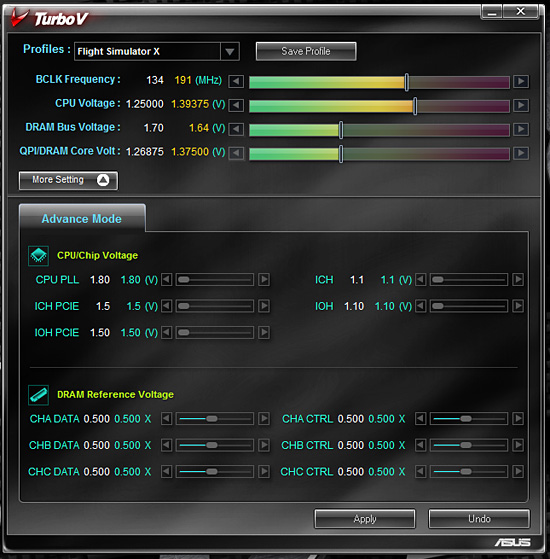
TurboV is ASUS' latest Windows based overclocking utility that features the ability to change most major BIOS settings to improve overclocking rates. It features profiles and works quite well, provided the memory timings and CPU multiplier have been set up properly prior to entering Windows. We are still hopeful that one of the major suppliers will offer the same capabilities as AMD's AOD utility.
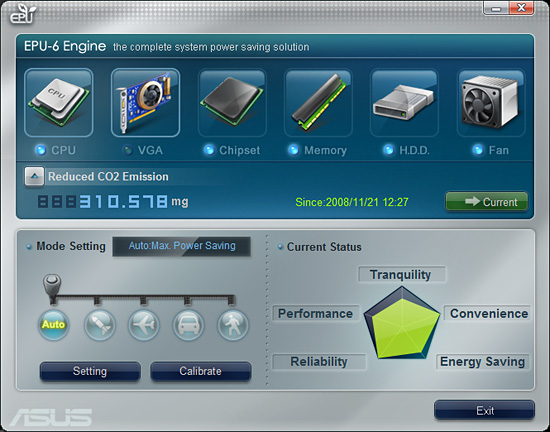
The P6T Deluxe features the EPU-6 power savings technology that can be accessed through the EPU software. The program offers five different modes or levels of energy savings. After hours of testing each setting, we found that leaving the application on Auto with a proper calibration worked best. Utilizing EPU-6 resulted in a power savings of 5W at both idle and load settings.
















78 Comments
View All Comments
TeXWiller - Friday, December 5, 2008 - link
Are you sure the 6 DIMM configuration is even supported with the current Nehalem at DDR3-1333 speed? Supermicro X8SAX, for example, does not support 6 DIMM configuration over DDR3-1066 speed, which is also the maximum Intel supported speed. This might explain some of those POST related problems.javamann - Friday, December 5, 2008 - link
I usually go for the high end board but I don't overclock. I expect if a board is built to run at a higher speed running at a normal speed would sit in the middle of the bell curve of it operating parameters. I would also expect it to just work. My bad.mjz - Friday, December 5, 2008 - link
not having support for 24GB ram of the bat is ridiculous.. With DDR3 ram going to be at a decent price next year, why not??? having 15GB as a ram disk would be amazing for many people.. this is MB companies being lasyAeroWB - Friday, December 5, 2008 - link
"Hey guys, Anand here. I'm writing this sub-section, not at Gary's request, but because I felt it was necessary."I totaly agree with you here, thanks for letting us know the size of the problem and Gary thanks for all those fixes.
"The point being is that we feel the lack of quality assurance before a product hits the market has now reached an all time high."
I do believe this is true, and I also have to say that I'm having problems with these kind of things for quite some years now, and I'm getting sick and tired of this.
For me the crap kickstarted in 2001 with an MSI mainboard, one brand I will never buy again...
(2001) MSI K7N420 Pro, it took MSI half a year to fix the issue of not being able to run the ram in dual channel mode on default speed without data corruption (the year I learned about memtest86) Also this board could not boot from an LSI 21320-R SCSI card and that problem has never been fixed (the Asus board with the same chipset could do it but my attempt to put that bioscode in the MSI bios failed)
(2003) Asus A7N8X-E Deluxe. onboard Marvell Gigabit card corrupted data, about one bit each 2GB so all my DVD downloads were corrupt! at 100Mbit it worked ok, an add-on Gb card also worked ok, lots of bios updates, no solution. Here's probably too much controllers cramped in not enough space. After 3 years upgrading the ram to 2GB didn't work, tried a lot of different brands. Bought an Intel D975XBX. (but the asus did support my LSI SCSI card!)
(2005) SuperMicro PDSGE, I finally bought a board with PCI-X for my Netware Server with SmartArray controller (which before was running in an Intel D945GTP desktopboard on PCI). The SmartArray card would boot, I got 2 special biosses for the board from Supermicro (great supportteam) but could't get it to work so added extra disk to boot the system, problem never solved. but it seems strange the controller working on a desktopboard and not on a server board. Updating the SmartArray also didn't help, My server still runs this board but now has a never HP SmartArray 641 that does work.
(2008) Asus M3A78-T, Razer Lachesis mouse is not working when powering up, I have to reinsert the usb connector of it everytime I start the computer to get it working (standby doesn't help) In 4 months I have flashed 3 newer bios versions in the mainboard and 2 in the mouse. Problem still exists. The Lachesis works fine in my IntelD975XBX system. My Razer Copperhead works fine in both (so I swapped the mice)
All listed boards are only from my private systems, I work at a computershop for over 10 years so needless to say I saw much more bios/board misery.
So far I have had the least problems with Intel boards but they also have their share of problems. Some years ago the company switched from Asus to Intel partially because alot of customers sometimes accidently overclocked their system (the boards got into the bios if they thought the post failed) and it got unstable. I really do not get why there are so many overclocker options while 90% of the people doesn't use it and just want a stable system. If for example I now look at Asus' website I almost get a heart attack, there are just too many mainboard models, most are not interesting at all, too many useless onboard crap, too expensive, absurd features (Aopen tube board for example), crap quality chipsets, etc. And in all that mess there's no board without overclocking and quality components except maybe some Intel models. Try to find a board that will get your vidcard and soundcard a real free non-shared interrupt, you can't. So there is too many stuff and not enough simple quality models. How can they test and support all those models, well they can't as we know now. They don't update drivers for their chipsets and onboard junk, so you have to search yourself. It looks like they haven't got enough time to do it good so why not make less models and get it working right. All of this holds true for many brands not only Asus. Maybe the economic crysis will have a positive side-effect of getting less different models but better supported and tested components.
Only pointing the finger at the manufacturers however is too easy.
Lots of review-sites focus on speed and overclocking, exagerating speed differences, over-hyping all kind of not-so-usefull onboard junk. Its all speed and quantity for the least money, so boards come factory overclocked, memory timings set to tight, onboard controllers that almost no-one needs etc. Just so it looks they provide more bang for the buck then the competition and get a better review score.
Lots of customers want the most speed and features for the least money, and forget about quality, support etc. Manufacturers look at the market and provide the crap that people scream for to get bashed by those customers for the crap, that will still buy the cheapest stuff next time. so the demand for shit doesn't decrease so the shit is provided again....
chizow - Friday, December 5, 2008 - link
I've felt the motherboard industry has been the weakest link in the PC industry for a very long time. I'm really glad someone finally called them out on it.I used to get REALLY upset at AT reviews because they'd publish a review making it seem these boards are rock solid stable with insane overclocking ability only to learn the ugly truth once I got the board home. It wouldn't take long to confirm it with other reports of underwhelming performance totally out of line with various reviews.
BIOS stability and quality certainly needs to improve, especially if board makers want to charge such insane prices for something that has always seemed low-end and interchangeable. Its probably a good thing that the market for mobo makers has shrunk, now they can focus on quality and add some value by making these things last longer than 6-9 months.
haukionkannel - Friday, December 5, 2008 - link
When I bought last time purhaced new PC. It had vorce USB support that I can imagine. Every time I put an new USB devile like USB stick, the computer freeces down after short or long period of time... Ower the years situation got better and better. But It reguired a lot of installing of new versions of Bios... And yeh, it was expensive motherboard from big maker.I am allmost somewhat customed to that the computer does not properly... and that is something that is not right! It should work better from the beginning.
Maybe we need some form of ISO standard for new mother board:
When these and these things works. You can start selling these items and review sites starts makin revies of them. Prewievs and beta programs are different story all to gether, but final product shoulf be better.
Now we only need a forum where to make that standard. I am quite sure that testers are even more frustracted with stupid errors they encounter than I who has never been "huge" over clocker.
- - - - - -
1) The machine must works with all specified memory configurations
2) Informed normal speeds should work with all integrated parts
3) the machine should be stable enough to run 24 hours burn test with adverticed speed specifications.
4) If you allso overclock it 10-20% That is good extra, but I expect more of these after more mature bios.
This list is not accurate enough, but somekind od insurance is needed! I Thank you for your hard work. For normal user these test you make are the only way of getting to know who can still make desent bios and who can not!
karhill - Friday, December 5, 2008 - link
"Catering or focusing exclusively to the extreme overclocking community has resulted in initial product launches that are focused on getting the highest possible results from a product at the expense of usability, compatibility, and stability."EXACTLY. Board stability and features that work are SO MUCH MORE IMPORTANT to me than overclocking. When I buy a board, that's what I'm looking for: stablity and features that work. Any consideration of overclocking is simply as an indicator for the qualities that matter to me; that is, I figure if board overclocks well, then it ought to be extra stable at stock speeds.
TennesseeTony - Friday, December 5, 2008 - link
The ASUS P6T Deluxe sounds exactly like what you've been describing. Screw 12GB of RAM, I can't get six 1GB sticks of OCZ-1333 to boot/post. 3GB great. 4GB, fine, no problem. 5GB, yep, works just fine. But put that sixth stick of memory in there, in ANY of the slots, and when that little annoying blue led by the mem slot turns on, the computer dies.Vista won't boot on the SAS controller (64bit). ASUS says it's Microsoft's problem, nothing wrong with them... XP64 finally loaded up, I think I'm on Windows installation number 14, still buggy.
I've been quite pissed with Anandtech for not coming through with all the promises of overclocking guides and such, but thank you, Anand, for finally shedding some light on the problems behind the delays, and an extra big thank you for deciding to only give them two strikes, then they're out! It's far past time!
pwndcake - Friday, December 5, 2008 - link
So, the motherboard companies are using yours and other tech sites for free QA testing? Am I reading this right? Not a bad idea really. They don't even have to pay the price of 12GB of RAM to get all the testing and feedback they need.tmath2 - Sunday, October 4, 2009 - link
Hear Hear !!! Call it like you see it! The though had occured to me also that the mob mfr's could save a ton on salaries by out-sourcing the Quality and Assurance departments to AnandTech and other hardware review websites!